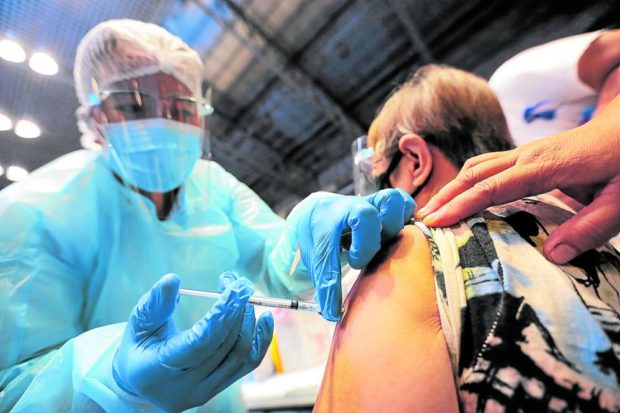No rise in COVID-19 cases, but ‘dramatic’ drop in jabs

GRANDMA KNOWS BEST A nurse vaccinates a senior citizen who ignored claims against COVID-19 vaccines. —INQUIRER FILE PHOTO
MANILA, Philippines — No rise in COVID-19 cases has been observed by the Department of Health (DOH) more than a week after Metro Manila and 38 other areas were put under alert level 1, according to Health Undersecretary Maria Rosario Vergeire.
Under the lowest alert level, increased people’s mobility was expected given the 100-percent workforce capacity implemented by employers as well as establishments’ full-capacity operations.
Vergeire said the government was strictly monitoring public mobility and issuing constant reminders of compliance with minimum health standards, and pushing the national vaccination drive.
But a “dramatic decline” in the number of vaccines administered in the past months has prompted the government to again schedule national vaccination days (NVD)—the fourth such period—starting today.
Different from the earlier three, the March 10-12 NVD4 will focus on the administration of primary jabs and booster shots in houses and in doctors’ clinics.
Article continues after this advertisementSecretary Carlito Galvez Jr., the chief implementer of the National Task Force Against COVID-19, spoke of the continuing drop in the number of vaccines administered during President Duterte’s “Talk to the People” aired on Monday night.
Article continues after this advertisementFrom an all-time high of 27.1 million shots in November, the output has decreased month after month, dropping 68 percent to 8.7 million in February.
“There has been a dramatic decline in our vaccinations. It’s really very low. The output really went down in February,” Galvez said.
‘New normal’
The National Capital Region (NCR) and 38 other areas shifted to alert level 1, or the “new normal,” on March 1.
The DOH earlier said it was prepared for the worst-case scenario under the lowest alert level. But Health Secretary Francisco Duque III on Tuesday said it was too early to declare alert level 1 nationwide, with the government yet to meet its vaccination target of 70 percent of the population and 80 percent of the elderly.
Still, the independent pandemic monitor OCTA Research said the NCR remained at “low” risk for COVID-19.
From March 2 to 8, it said, the NCR had a “very low” reproduction rate (0.24), and positivity rate (3 percent).
Jab priorities
OCTA said seven of the 12 provinces in Central Luzon and Calabarzon—Aurora, Bulacan, Laguna, Pampanga, Quezon, Rizal and Zambales—were already at “very low” risk.
Remaining at “low risk” are the provinces of Bataan, Batangas, Cavite, Nueva Ecija and Tarlac.
Vergeire said the target of NVD4 was 1.8 million people.
“The DOH, through the support of its partners, will reach remote and far-flung areas: locations where indigenous peoples reside and those living in geographically isolated and disadvantaged areas,” she said in a statement released on Tuesday.
“The targets that were set for NVD4 are more contextualized in consideration of areas with low vaccination rates and coverage. Further, individuals due for second doses, the remaining senior citizen population (A2), as well as adolescents are among those to be prioritized,” she said.
Vergeire said house-to-house vaccination would be conducted “in coordination with local government units (LGUs), and the private sector, pharmacies, primary care clinics and occupational health clinics, as well as air, sea and transportation terminals.”
“The churches, parishes, and cathedrals are also extending [their] aid to serve as vaccination sites for a further reach of inoculation,” she said.
She encouraged the public to participate in NVD4, reiterating that the benefits outweighed the risk of possible adverse effects.
She said the DOH, together with the Department of Labor and Employment and the Civil Service Commission, were working to excuse employees and workers from absences if they would be jabbed during NVD4.
‘Saturation point’
Galvez said that under alert level 1, vaccination centers had reached “saturation point,” with many vacant and few persons wanting to get jabbed.
“We will be needing other strategies to get more vaccinees,” he said.
Galvez said NVD4 was aimed at administering booster shots to 1.8-2 million people age 12 and above, and primary doses to senior and immunocompromised citizens.
The government is again partnering with the Philippine Medical Association (PMA), this time in bringing the vaccination to the clinics of its physician-members nationwide.
The vaccines will still be free of charge courtesy of the national government, and coursed through the LGUs.
Vaccination will also be conducted in all the existing jab sites in schools, barangays, malls, pharmacies, workplaces and other establishments in all the 17 regions nationwide.
Said PMA president Dr. Benito Atienza: “There will no longer be a hindrance for the public to get their COVID-19 vaccines. Before, they would say that there were long lines in vaccination centers, or they have jobs. Now, anytime, anywhere, you can get your vaccine right in the clinic of your doctor.”
A year since the national vaccination program began, 63.8 million Filipinos, or almost 58 percent of the population of more than 110 million, have been jabbed.
Only 10.6 million have received a booster shot.
RELATED STORIES
PH logs 580 new COVID-19 infections, lowest since Dec. 28
UN chief warns COVID-19 pandemic not over, decries vaccine inequality
OCTA Research sees PH’s COVID-19 cases dropping to 300 a day by end-March